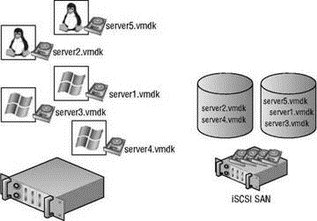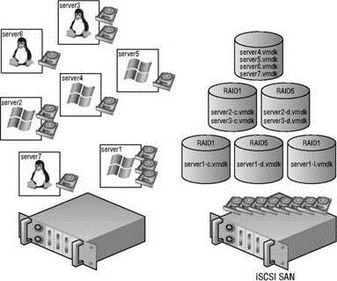Книга: Mastering VMware® Infrastructure3
Predictive Scheme
Predictive Scheme
The predictive scheme overcomes the limitations of the adaptive scheme but introduces administrative challenges of its own. The predictive involves the additional administrative effort of customizing LUNs to be specific for individual virtual machines. Take the following example: When administrators deploy a new server to play host to a database application, it is a common practice to enhance database performance by implementing multiple disks with characteristics specific to the data stored on the disk. On a database server, this often means a RAID 1 (mirror) volume for the operating system, a RAID 5 volume for the database files, and another RAID 1 volume for the database logs. Using the predictive scheme to architect a LUN solution for this database server would result in three SAN LUNs built on RAID arrays as needed by the database server. The sizes of the LUNs would depend on the estimated sizes of the operating system, database, and log files. Figure 4.8 shows this type of predictive approach to LUN design. Table 4.2 outlines all of the pros and cons for each of the LUN design strategies.

Figure 4.7 The adaptive scheme involves creating a small number of LUNs that are larger in size and play host to virtual machine disk files for multiple virtual machines.

Figure 4.8 The predictive scheme, though administratively more involved, offers better performance measures for critical virtual machines.
Table 4.2: Adaptive and Predictive Scheme Comparisons
| Type of Scheme | Pros | Cons |
|---|---|---|
| Adaptive | Less need for SAN administrator Easy resizing of virtual disks Easy snapshot management Less volume management | Possible undersizing of LUN, resulting in greater administrative effort to create new LUNs Possible oversizing of LUN, resulting in wasted storage space |
| Predictive | Less contention on each VMFS More flexible share allocation and management Less wasted space on SAN storage RAID specificity for VMs Greater multipathing capability Support for Microsoft clusters Greater backup policy flexibility | Greater administrative overhead for LUN masking Greater administrative effort involved in VMotion, DRS, and HA planning |
As we noted earlier in this section, the most appropriate solution will most likely involve a combination of the two design schemes. You may find a handful of virtual machines where performance is unaffected by storing all the virtual machine disk files on the same LUN, and at the same time you will find those virtual machines that require a strict nonsharing approach for the virtual machine disk files. But in between the two extremes, you will find the virtual machines that require specific RAID characteristics but, at the same time, can share LUN access with multiple virtual machines. Figure 4.9 shows a LUN design strategy that incorporates both the adaptive and predictive schemes as well as a hybrid approach.

Figure 4.9 Neither the adaptive nor the predictive scheme will be the most appropriate solution in all cases, which means most environments will be built on a hybrid solution that involves both philosophies.
With all of the effort that will be put into designing the appropriate LUN structures, you will undoubtedly run into situations in which the design will require change. Luckily for the VI3 administrative community, the product is very flexible in the way virtual machine disk files are managed. In just a few short steps, a virtual machine's disk files can be moved from one LUN to another. The simplified nature of relocating disk files means that if you begin with one approach and discover it does not fit your environment, you can easily transition to a more suitable LUN structure. In Chapter 6, we'll detail the steps required to move a virtual machine from one datastore to another.




